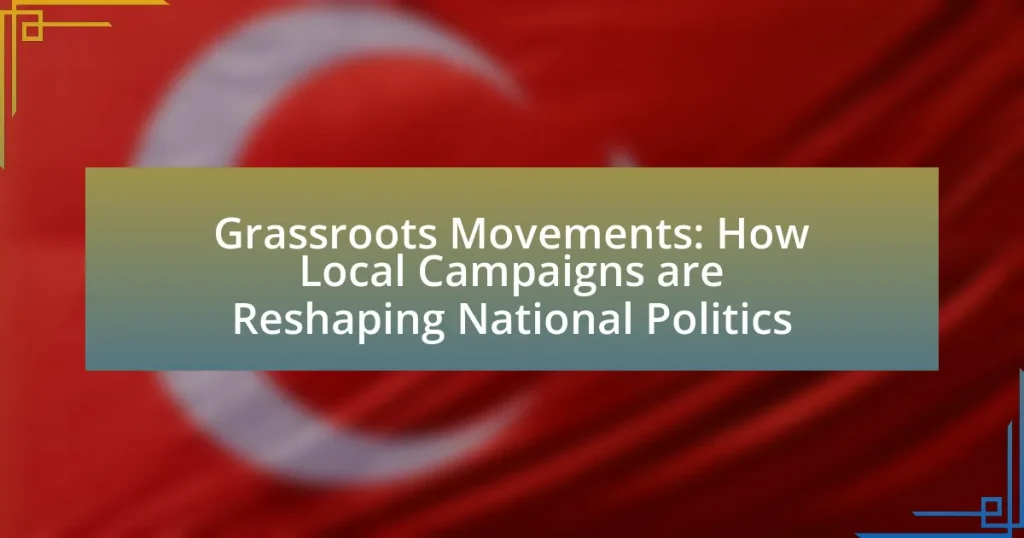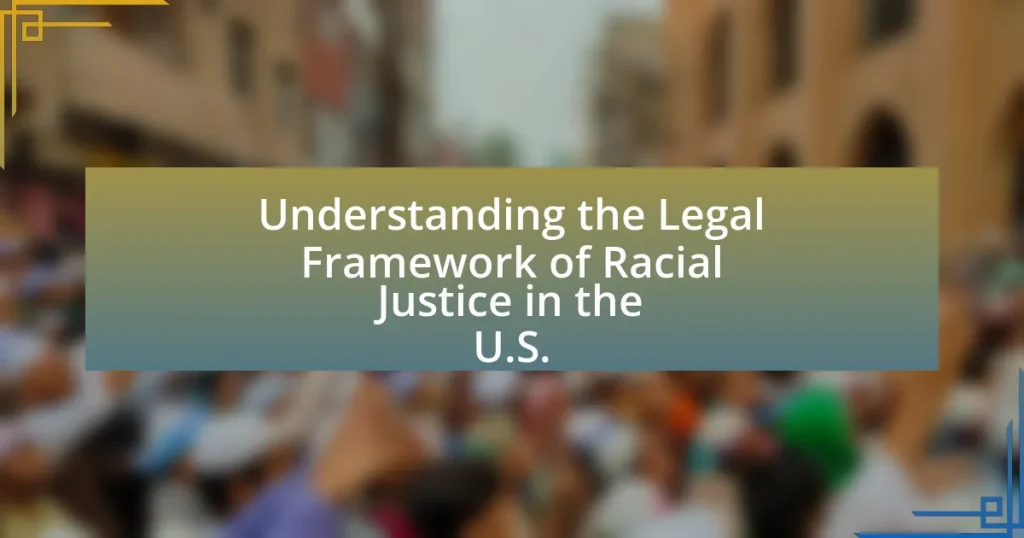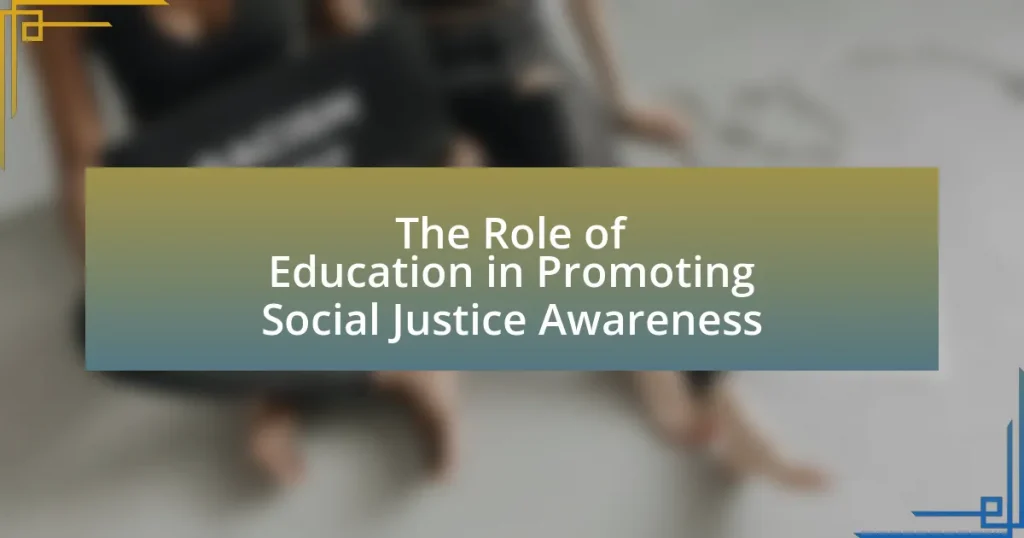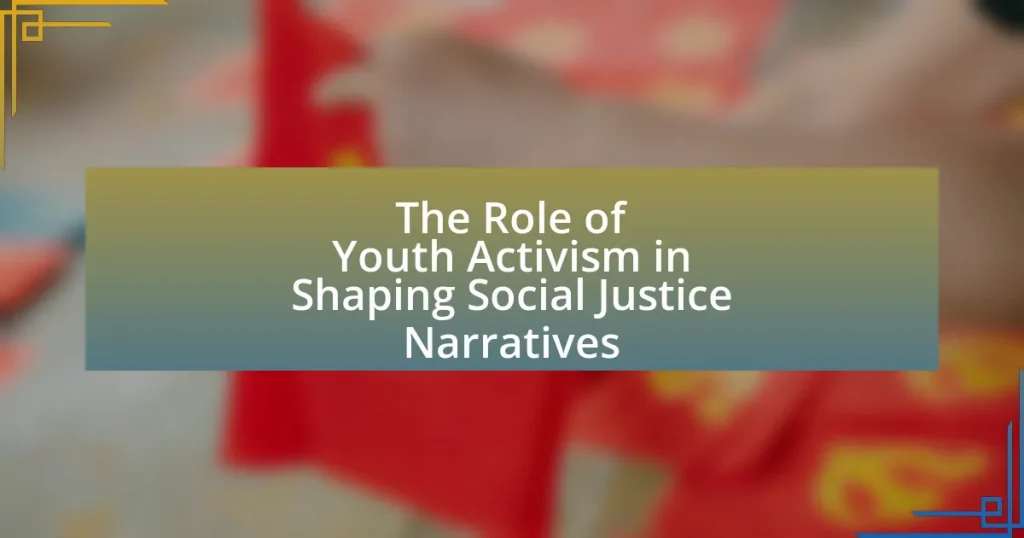Grassroots movements are organized efforts by ordinary individuals at the local level aimed at achieving social or political change. This article explores the characteristics, importance, and impact of grassroots movements in modern politics, highlighting their role in mobilizing communities around specific issues such as social justice and environmental protection. It examines how grassroots initiatives differ from traditional political campaigns, the strategies they employ to engage local communities, and the challenges they face, including funding limitations and political opposition. Additionally, the article discusses notable examples of successful grassroots movements and their influence on national policy-making, emphasizing the growing significance of these movements in reshaping political agendas and fostering civic engagement.

What are Grassroots Movements?
Grassroots movements are organized efforts by ordinary people at the local level to effect social or political change. These movements typically arise from community concerns and aim to mobilize individuals to advocate for specific issues, such as environmental protection, social justice, or political reform. For example, the Civil Rights Movement in the United States during the 1960s was a grassroots effort that involved local activists working to end racial segregation and discrimination. Grassroots movements often rely on community engagement, volunteerism, and local resources to build momentum and influence larger political agendas.
How do Grassroots Movements differ from traditional political campaigns?
Grassroots movements differ from traditional political campaigns primarily in their structure and approach to mobilization. Grassroots movements are typically community-driven, relying on local volunteers and small donations to build support from the ground up, whereas traditional political campaigns often depend on established party structures, larger financial contributions, and professional staff. For example, the 2016 Bernie Sanders campaign exemplified a grassroots approach by emphasizing small donations and volunteer engagement, contrasting with the more top-down strategies of traditional campaigns like Hillary Clinton’s, which relied heavily on party infrastructure and major donor funding. This fundamental difference highlights how grassroots movements can empower individuals and foster community involvement in political processes.
What are the key characteristics of Grassroots Movements?
Grassroots movements are characterized by their community-driven nature, emphasizing local participation and engagement. These movements typically arise from the collective efforts of individuals at the local level, often mobilizing around specific social, political, or environmental issues. They rely on grassroots organizing strategies, such as door-to-door canvassing, community meetings, and social media outreach, to build support and raise awareness. Additionally, grassroots movements often prioritize inclusivity and diversity, ensuring that marginalized voices are heard and represented. Historical examples, such as the Civil Rights Movement in the United States, illustrate how grassroots efforts can lead to significant societal change, demonstrating the power of local activism in shaping national policies.
Why are Grassroots Movements important in modern politics?
Grassroots movements are important in modern politics because they empower ordinary citizens to influence decision-making and policy changes at local, national, and global levels. These movements often arise in response to specific social issues, mobilizing community members to advocate for change, thereby increasing political engagement and representation. For example, the Black Lives Matter movement has significantly impacted discussions on racial justice and police reform in the United States, demonstrating how grassroots activism can shape national dialogue and policy. Additionally, research from the Pew Research Center indicates that grassroots campaigns can effectively mobilize voters, leading to higher turnout rates and greater political participation, which are crucial for a healthy democracy.
What role do local communities play in Grassroots Movements?
Local communities serve as the foundational backbone of grassroots movements by mobilizing individuals, resources, and local knowledge to advocate for change. These communities foster collective action, enabling residents to identify shared issues and organize efforts to address them, often leading to significant political and social impact. For instance, the Civil Rights Movement in the United States was largely driven by local community organizations that coordinated protests and voter registration drives, demonstrating how grassroots efforts can influence national policy. Additionally, studies show that grassroots movements with strong local community involvement are more likely to achieve their goals, as they leverage local networks and trust to build momentum and engage broader audiences.
How do local issues drive the formation of Grassroots Movements?
Local issues drive the formation of grassroots movements by highlighting specific community concerns that resonate with individuals, prompting collective action. When residents face challenges such as environmental degradation, social injustice, or economic inequality, these localized problems often mobilize citizens to organize and advocate for change. For instance, the Flint water crisis in Michigan galvanized local residents to form movements demanding clean water and accountability, illustrating how immediate issues can catalyze broader activism. This phenomenon is supported by research indicating that grassroots movements often emerge in response to perceived injustices that directly affect people’s lives, fostering a sense of urgency and community solidarity.
What strategies do local communities use to mobilize support?
Local communities mobilize support through grassroots organizing, coalition building, and leveraging social media. Grassroots organizing involves community members actively engaging in outreach, education, and mobilization efforts to raise awareness about specific issues. Coalition building allows communities to unite with various organizations and stakeholders, amplifying their collective voice and resources. Social media serves as a powerful tool for communication and mobilization, enabling communities to share information quickly, rally support, and coordinate actions effectively. These strategies have been proven effective in numerous local campaigns, such as the Fight for $15 movement, which successfully advocated for higher minimum wages across various cities by utilizing these methods.
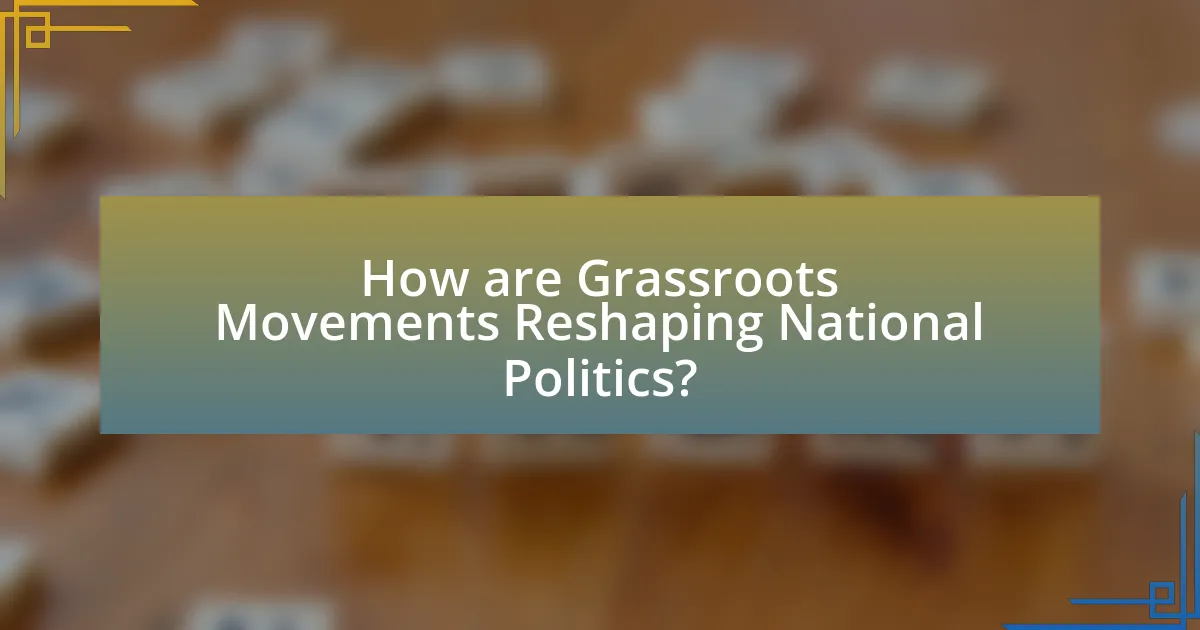
How are Grassroots Movements Reshaping National Politics?
Grassroots movements are reshaping national politics by mobilizing local communities to influence policy and electoral outcomes. These movements leverage social media and community organizing to amplify voices that are often marginalized, leading to significant shifts in public opinion and political agendas. For instance, the Black Lives Matter movement has catalyzed national conversations on racial justice and police reform, resulting in legislative changes in various states. Additionally, the rise of environmental movements, such as those advocating for the Green New Deal, has pressured political leaders to prioritize climate action, demonstrating the tangible impact of grassroots activism on national policy discussions.
What impact do Grassroots Movements have on national policy-making?
Grassroots movements significantly influence national policy-making by mobilizing public opinion and advocating for specific issues. These movements often raise awareness about social, environmental, or political concerns, leading to increased pressure on policymakers to address these issues. For instance, the Civil Rights Movement in the 1960s successfully pushed for landmark legislation such as the Civil Rights Act of 1964 and the Voting Rights Act of 1965, demonstrating how grassroots activism can lead to substantial policy changes. Additionally, contemporary movements like Black Lives Matter have prompted national discussions on police reform and racial justice, illustrating their ongoing impact on shaping policy agendas at the national level.
How do Grassroots Movements influence political agendas?
Grassroots movements influence political agendas by mobilizing community members to advocate for specific issues, thereby pressuring policymakers to respond to their demands. These movements often utilize social media and local organizing to raise awareness and build coalitions, which can lead to significant shifts in public opinion and legislative priorities. For instance, the Black Lives Matter movement has successfully brought issues of racial injustice and police reform to the forefront of national political discourse, resulting in policy discussions and legislative proposals at various levels of government. This demonstrates how grassroots activism can effectively shape political agendas by amplifying marginalized voices and creating a sense of urgency around critical social issues.
What examples illustrate the success of Grassroots Movements in changing policies?
Grassroots movements have successfully changed policies through various notable examples. One significant instance is the Civil Rights Movement in the United States, which led to the passage of the Civil Rights Act of 1964 and the Voting Rights Act of 1965, fundamentally altering racial segregation laws and ensuring voting rights for African Americans. Another example is the environmental movement, particularly the grassroots campaign against the Keystone XL pipeline, which influenced the Obama administration to reject the project in 2015, highlighting the power of local activism in shaping national energy policy. Additionally, the Women’s March in 2017 mobilized millions and contributed to increased political engagement, resulting in a record number of women elected to Congress in the 2018 midterm elections, showcasing how grassroots efforts can lead to significant electoral and policy changes.
Why are Grassroots Movements gaining traction in recent years?
Grassroots movements are gaining traction in recent years due to increased access to digital communication tools and a growing public disillusionment with traditional political structures. The rise of social media platforms has enabled local campaigns to mobilize supporters quickly and effectively, allowing them to reach wider audiences and organize events with minimal resources. Additionally, studies indicate that public trust in government has declined, with a 2021 Gallup poll showing that only 20% of Americans have confidence in Congress, prompting citizens to seek alternative avenues for political engagement. This combination of technological empowerment and dissatisfaction with established political entities has led to a surge in grassroots activism, as individuals feel more capable of influencing change at local and national levels.
What social and technological factors contribute to the rise of Grassroots Movements?
Social and technological factors significantly contribute to the rise of grassroots movements by enhancing communication and mobilization capabilities. Socially, increased awareness of social injustices and inequalities drives communities to organize and advocate for change, as seen in movements like Black Lives Matter, which gained momentum through shared experiences of systemic racism. Technologically, the proliferation of social media platforms allows for rapid dissemination of information, enabling grassroots organizations to reach wider audiences and coordinate efforts effectively, exemplified by the Arab Spring, where platforms like Twitter and Facebook played crucial roles in mobilizing protests. These factors create an environment conducive to grassroots activism, empowering individuals to effect change at local and national levels.
How do Grassroots Movements leverage social media for their campaigns?
Grassroots movements leverage social media by utilizing platforms to mobilize supporters, disseminate information, and amplify their messages. These movements create targeted campaigns that engage users through shareable content, fostering community involvement and increasing visibility. For example, the #BlackLivesMatter movement effectively used Twitter and Instagram to raise awareness and organize protests, demonstrating the power of social media in reaching a wide audience quickly. Additionally, studies show that social media can enhance fundraising efforts, with platforms like GoFundMe enabling grassroots organizations to gather financial support from a broader base.
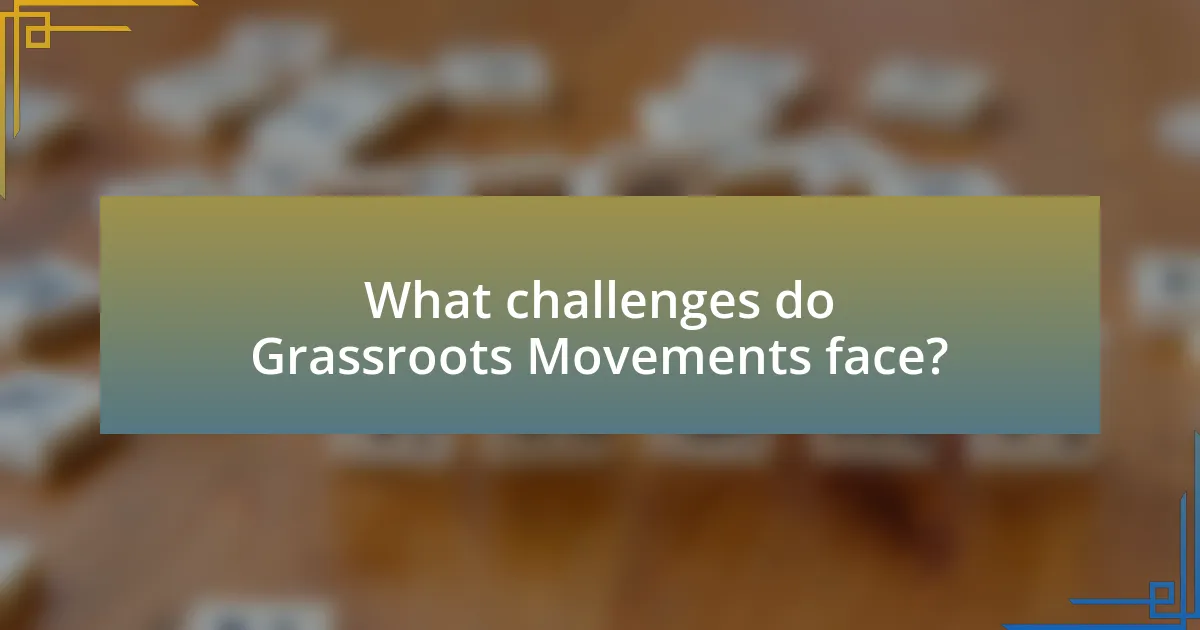
What challenges do Grassroots Movements face?
Grassroots movements face significant challenges, including limited funding, organizational capacity, and political resistance. Limited funding restricts their ability to mobilize resources effectively, as many rely on small donations and volunteer efforts rather than large financial backers. Organizational capacity is often hindered by a lack of infrastructure and professional expertise, making it difficult to coordinate activities and sustain momentum. Political resistance manifests through pushback from established political entities and institutions, which may view grassroots initiatives as threats to their power. For instance, research by the Stanford Social Innovation Review highlights that grassroots movements often struggle to gain media attention and public support in the face of entrenched political interests.
How do funding and resources affect the effectiveness of Grassroots Movements?
Funding and resources significantly enhance the effectiveness of grassroots movements by providing essential support for outreach, organization, and advocacy efforts. Adequate financial backing allows these movements to mobilize volunteers, conduct campaigns, and reach wider audiences through advertising and events. For instance, the 2018 midterm elections in the United States saw grassroots organizations like Indivisible raise over $20 million, enabling them to effectively challenge incumbents and influence voter turnout. This financial support directly correlates with increased visibility and impact, demonstrating that well-funded grassroots movements can achieve substantial political change.
What are common funding sources for Grassroots Movements?
Common funding sources for grassroots movements include individual donations, crowdfunding platforms, small business sponsorships, and grants from nonprofit organizations. Individual donations often come from community members who support the cause, while crowdfunding platforms like GoFundMe allow movements to reach a wider audience for financial support. Small businesses may contribute through sponsorships or partnerships, recognizing the mutual benefits of supporting local initiatives. Additionally, nonprofit organizations often provide grants to grassroots movements that align with their missions, facilitating the growth and impact of these campaigns.
How can Grassroots Movements overcome resource limitations?
Grassroots movements can overcome resource limitations by leveraging community engagement and utilizing digital platforms for fundraising and awareness. Community engagement fosters local support, which can lead to volunteer mobilization and in-kind donations, effectively supplementing financial resources. For instance, the 2018 campaign of Alexandria Ocasio-Cortez demonstrated how grassroots fundraising, primarily through small donations from a large number of supporters, can significantly reduce reliance on large donors. Additionally, digital platforms like social media enable grassroots movements to reach wider audiences at minimal costs, facilitating the dissemination of information and mobilization efforts. This combination of community support and digital outreach has proven effective in amplifying the impact of grassroots initiatives despite limited financial resources.
What opposition do Grassroots Movements encounter?
Grassroots movements encounter significant opposition from established political entities, corporations, and institutional frameworks. These established groups often perceive grassroots initiatives as threats to their power and influence, leading to efforts to undermine or discredit them. For example, large corporations may deploy lobbying tactics to sway legislation against grassroots causes, while political parties might marginalize grassroots candidates through funding disparities and media bias. Additionally, grassroots movements frequently face challenges in mobilizing resources and gaining media attention, which can hinder their effectiveness in advocating for change.
How do established political entities respond to Grassroots Movements?
Established political entities often respond to grassroots movements with a combination of co-optation, opposition, and adaptation. Co-optation occurs when these entities attempt to absorb the movement’s goals or leaders to neutralize its impact, as seen in the Democratic Party’s engagement with the Occupy Wall Street movement. Opposition may manifest through public criticism or legislative measures aimed at undermining the movement, exemplified by various state-level laws targeting protest activities. Adaptation involves integrating grassroots demands into their platforms, which has been evident in the rise of progressive policies within mainstream parties in response to movements like Black Lives Matter. These responses reflect the entities’ recognition of grassroots movements as significant forces that can influence public opinion and electoral outcomes.
What strategies do Grassroots Movements use to counteract opposition?
Grassroots movements counteract opposition through strategies such as community organizing, coalition building, and leveraging social media. Community organizing involves mobilizing local individuals to advocate for shared goals, which strengthens collective power and resilience against opposition. Coalition building allows grassroots movements to unite with other organizations, amplifying their voice and resources, as seen in the collaboration between various environmental groups to combat climate change policies. Additionally, leveraging social media enables grassroots movements to disseminate information rapidly, engage supporters, and counter misinformation, exemplified by the use of platforms like Twitter and Facebook during the Black Lives Matter protests to organize events and share real-time updates. These strategies collectively enhance the effectiveness of grassroots movements in overcoming challenges posed by opposition.
What best practices can enhance the effectiveness of Grassroots Movements?
Effective grassroots movements can be enhanced by building strong community engagement, utilizing social media for outreach, and fostering collaboration among diverse groups. Strong community engagement ensures that the movement resonates with local needs and values, as evidenced by the success of the Black Lives Matter movement, which mobilized local communities to address systemic racism. Utilizing social media platforms allows for rapid dissemination of information and mobilization of supporters, as demonstrated by the viral spread of the Ice Bucket Challenge, which raised awareness and funds for ALS. Collaboration among diverse groups broadens the movement’s reach and impact, as seen in the Women’s March, which united various organizations and individuals to advocate for women’s rights on a national scale. These practices collectively contribute to the effectiveness of grassroots movements by amplifying their message and fostering a sense of community ownership.
How can Grassroots Movements effectively engage their communities?
Grassroots movements can effectively engage their communities by fostering inclusive participation and utilizing local networks for outreach. By organizing community meetings, these movements create spaces for dialogue, allowing residents to voice their concerns and ideas. Research indicates that grassroots initiatives that prioritize community input, such as the “Community Organizing for Social Change” model, enhance civic engagement and mobilization (source: “The Power of Community Organizing,” by Marshall Ganz). Additionally, leveraging social media platforms enables grassroots movements to disseminate information rapidly and connect with a broader audience, thereby increasing community involvement and awareness.
What role does coalition-building play in the success of Grassroots Movements?
Coalition-building is essential for the success of grassroots movements as it amplifies their reach and influence. By uniting diverse groups with shared goals, grassroots movements can pool resources, share expertise, and mobilize larger numbers of supporters. For instance, the 2017 Women’s March in the United States successfully brought together various organizations, including labor unions and civil rights groups, demonstrating how coalition-building can create a powerful collective voice that impacts national discourse and policy. This collaboration not only enhances visibility but also strengthens advocacy efforts, making it more likely for grassroots movements to achieve their objectives.










